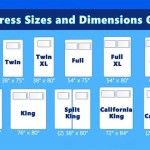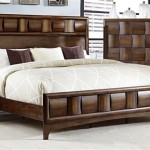Double Bed Size Compared to Queen: A Comprehensive Guide
Selecting the right bed size is a crucial decision that impacts sleep quality, bedroom space utilization, and overall comfort. Among the various options available, the double (also known as full) and queen sizes are popular choices, particularly for individuals, couples, and guest rooms. Understanding the specific dimensions and characteristics of each size is essential for making an informed purchase that aligns with individual needs and spatial constraints. This article provides a detailed comparison between double and queen beds, examining their dimensions, suitability for different users, and factors to consider when choosing between the two.
The primary distinction between a double and queen bed lies in their dimensions. Understanding these dimensions is fundamental in determining which bed size is more appropriate for a given situation. A standard double bed typically measures 54 inches wide and 75 inches long. This size offers ample space for a single sleeper, allowing for comfortable movement during the night. However, a double bed may feel cramped for two adults, especially if they are accustomed to more personal space or if one or both individuals tend to move frequently while sleeping.
In contrast, a queen bed measures 60 inches wide and 80 inches long. The additional six inches in width and five inches in length provide a significantly more spacious sleeping surface compared to a double bed. This additional space makes a queen bed a more comfortable option for couples, offering each person more room to stretch out and sleep undisturbed. The added length is also beneficial for taller individuals who may find a double bed too short.
Key Point 1: Size and Dimensions – A Quantitative Comparison
The difference in size between double and queen beds directly translates to varying levels of comfort and suitability for different types of sleepers. To quantify this difference, consider the surface area of each bed. A double bed offers approximately 4,050 square inches of sleeping space (54 inches x 75 inches). A queen bed, on the other hand, provides approximately 4,800 square inches of sleeping space (60 inches x 80 inches). This represents an increase of approximately 18.5% in sleeping surface area, a significant difference that can impact sleep quality, especially for couples.
The six-inch width difference in queen beds offers each sleeping partner an additional three inches of personal space. While this may seem minimal, it can substantially reduce the feeling of being crowded, minimizing disturbances caused by a partner's movements. Similarly, the five-inch length difference can enhance comfort for taller individuals, preventing their feet from hanging off the edge of the bed. For individuals who are sensitive to space limitations or who require more room to move during sleep, the queen size advantage is quite clear. It is essential to consider the dimensions in the context of the bedroom size available and the number of intended sleepers.
Furthermore, the dimensions also affect the availability of bedding and accessories. Queen-sized bedding, including sheets, comforters, and blankets, is generally more widely available and comes in a greater variety of styles and materials compared to double-sized bedding. This broader selection can provide more options for personalization and aesthetic preferences. However, double-sized bedding is often more affordable and may be easier to find in smaller or specialized retail outlets.
When assessing size and dimensions, it is also pertinent to consider the overall footprint of the bed frame. While the mattress dimensions are the primary determining factor in sleeping space, the frame's design and size contribute to the overall space occupied in the room. Some bed frames may add several inches to the length and width of the mattress, which can further influence the bed’s spatial impact. A thorough measurement of the available space in the bedroom and careful consideration of the frame’s dimensions are important aspects of the decision-making process.
Key Point 2: User Suitability and Intended Use
The intended use of the bed and the characteristics of the individuals who will be sleeping on it are crucial factors in determining the most appropriate size. A double bed is often suitable for single adults who prefer a more compact sleeping arrangement or for smaller guest rooms where space is limited. It provides sufficient space for comfortable sleep without overwhelming the room. A double bed can also be a practical choice for teenagers transitioning from a twin bed, offering more room to grow without the expense and space requirements of a queen bed.
However, a double bed is generally not recommended for couples or individuals who require a significant amount of personal space. The limited width can lead to discomfort, disturbed sleep, and a feeling of being cramped. Couples who frequently toss and turn during the night or who have differing sleep schedules may find a double bed particularly unsuitable. In such cases, the increased width and length of a queen bed provide a more accommodating sleeping environment.
Queen beds are often the preferred choice for couples due to their enhanced sleeping space and comfort. They allow each partner to sleep more independently, minimizing disturbances caused by movement. Additionally, the added length of a queen bed makes it a more suitable option for taller individuals, providing ample room to fully stretch out without feeling restricted. A queen bed is also a practical choice for master bedrooms in homes and apartments, providing a comfortable sleeping arrangement while maintaining a sense of spatial balance.
Beyond couples and individuals, queen beds are also a popular choice for guest rooms that are intended to accommodate both single guests and couples. This versatility allows the room to adapt to different occupancy scenarios, providing a more comfortable experience for a wider range of visitors. While a double bed may suffice for single guests, a queen bed offers a more luxurious and accommodating option that enhances the overall guest experience.
Considering age, physical condition, and sleeping habits is also important. Individuals with mobility issues may find it easier to get in and out of a higher queen bed, especially if it is paired with a supportive mattress. Similarly, individuals with conditions that require more space for movement during sleep, such as restless leg syndrome, may benefit from the extra room offered by a queen bed. These factors should be evaluated in conjunction with the available space and budget to make an informed decision that prioritizes comfort and well-being.
Key Point 3: Space Considerations and Budgetary Implications
The size of the bedroom and the overall budget are significant factors that influence the choice between a double and queen bed. A double bed is generally more suitable for smaller bedrooms where space is limited. Its smaller dimensions allow for more room to maneuver around the bed and accommodate other furniture items, such as dressers, nightstands, and chairs. In contrast, a queen bed requires a larger bedroom to ensure adequate space for comfortable movement and to prevent the room from feeling cramped.
Before purchasing a bed, it is essential to measure the dimensions of the bedroom and consider the placement of other furniture pieces. A general rule of thumb is to allow at least two feet of space on each side of the bed, and at the foot of the bed, to facilitate easy movement. This ensures that the room remains functional and comfortable, even with the bed in place. In smaller bedrooms, a double bed may be the only viable option to maintain a sense of spatial balance and functionality.
Budgetary constraints also play a crucial role in the decision-making process. Double beds and their corresponding bedding and accessories are typically less expensive than queen-sized counterparts. This cost difference can be significant, especially for individuals or families on a tight budget. While a queen bed may offer more comfort and space, the additional expense may not be justifiable for all situations.
The cost of mattresses, bed frames, bedding, and other accessories should be considered when comparing the overall expense of a double and queen bed. Queen-sized mattresses often require more expensive materials and construction techniques, which can contribute to a higher price point. Similarly, queen-sized bedding and accessories, such as sheets, comforters, and blankets, are generally more expensive due to the larger size and greater material requirements. It is vital to compare prices across different retailers and brands to find the best value for money.
In addition to the initial purchase cost, ongoing maintenance and replacement expenses should also be considered. Mattresses typically need to be replaced every 7-10 years, depending on the quality and usage. The cost of replacing a queen-sized mattress will generally be higher than replacing a double-sized mattress. Similarly, the cost of replacing damaged or worn-out bedding and accessories will also be higher for queen-sized items. These long-term cost implications should be factored into the overall budgetary analysis to ensure that the chosen bed size is sustainable and affordable.
Ultimately, the choice between a double and queen bed involves a careful evaluation of individual needs, spatial constraints, and budgetary considerations. By thoroughly assessing these factors, individuals can make an informed decision that maximizes comfort, functionality, and long-term value.

Bed Guide 5 Tips On Choosing The Right Size Mattress Archdaily

Bed Dimensions A Guide To Ing The Perfect In India Solara Home

Mattress Sizes Chart And Bed Dimensions Guide Amerisleep

Mattress Size Guide

Bed Sizes In Mexico Cabo Real Estate Services Best Website

Bed Sizes And Dimensions Guide Eachnight

King Bed Vs Queen B2c Furniture

Bed Sizes In Malaysia A Comprehensive Guide 2024 Cuura Space

King Vs Queen Bed Size Mattress What Is The Difference Nectar Sleep

Queen Bed Dimensions A Ing Guide Nectar Sleep








